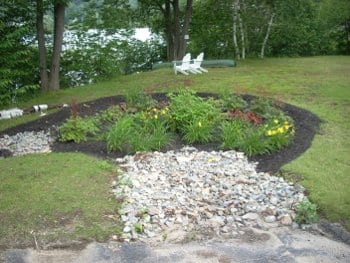by Ed Himlan
A rain garden is a small natural area that helps to cleanse stormwater before it flows into brooks and ponds. Rain gardens, also called bioretention areas, allow stormwater from impervious surfaces, such as streets and driveways, to soak into the ground. The plants and soils in rain gardens remove pollution from the stormwater and keep streams healthy. Attractive flowers and shrubs offer food and habitat for butterflies and birds, as well as make neighborhoods more appealing places.

Rain gardens have a six to ten inch dip in the center for rain water to seep into the ground. The low area retains the first inch of stormwater with concentrated pollutants from streets and other hard surfaces. On hot days, rain gardens will cool warm water flowing from dark pavement by putting it in the soil. This groundwater flows to streams between storms, and is essential to maintain the health of aquatic ecosystems.
Benefits of Rain Gardens
Polluted runoff is a big problem in cities where forests and fields have been replaced by streets, buildings, sidewalks, parking lots and other hard surfaces. Runoff from hard surfaces will carry chemicals and bacteria into catch basins and drain pipes that discharge dirty stormwater into streams. Stormwater problems are the major cause of flooding and pollution that can damage property, contaminate water supplies, harm aquatic life, and spoil recreational uses of lakes and brooks.
Collecting and treating stormwater with rain gardens has many water quality benefits:
- Reduces sand, silt, grease, oil and metals
- Plants and soils remove phosphorus, nitrogen and other nutrients
- Microbes in mulch and soils lessen bacteria levels in street runoff
Many cities across the country are restoring healthy streams and reducing water treatment costs by installing rain gardens and bioretention areas. In addition to municipal projects, homeowners, businesses, schools and churches are adding rain gardens to help renew the vitality of community waters. There are many Internet websites that supply information and guidance about how to build rain gardens:

